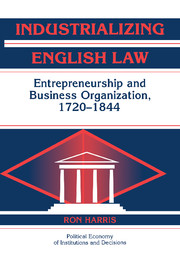Book contents
- Frontmatter
- Contents
- List of Tables
- Acknowledgements
- Introduction
- 1 The Legal Framework
- PART I BEFORE 1720
- PART II 1721–1810
- 4 Two Distinct Paths of Organizational Development: Transport and Insurance
- 5 The Joint-Stock Business Corporation
- 6 Trusts, Partnerships, and the Unincorporated Company
- 7 The Progress of the Joint-Stock Organization
- PART III 1800–1844
- Conclusion
- Appendix 1 The Rise and Decline of the Major Trading Corporations
- Appendix 2: Capital of Joint-Stock Companies Circa 1810
- Bibliography
- Index of Cases
- Index of Statutes
- General Index
5 - The Joint-Stock Business Corporation
Published online by Cambridge University Press: 12 August 2009
- Frontmatter
- Contents
- List of Tables
- Acknowledgements
- Introduction
- 1 The Legal Framework
- PART I BEFORE 1720
- PART II 1721–1810
- 4 Two Distinct Paths of Organizational Development: Transport and Insurance
- 5 The Joint-Stock Business Corporation
- 6 Trusts, Partnerships, and the Unincorporated Company
- 7 The Progress of the Joint-Stock Organization
- PART III 1800–1844
- Conclusion
- Appendix 1 The Rise and Decline of the Major Trading Corporations
- Appendix 2: Capital of Joint-Stock Companies Circa 1810
- Bibliography
- Index of Cases
- Index of Statutes
- General Index
Summary
My focus throughout the present work is on four features of the business organization: the nature of the legal entity, raising joint-stock capital and transferring interest, the degree of limitation on personal liability, and the existence of entry barriers. The present chapter examines the application of these features to the business corporation. I discuss the needs of the English economy in terms of capital, and how these needs could be fulfilled by raising joint-stock capital in the financial markets of the time. I then analyze the demand for limited liability in eighteenth-century England and the degree to which this privilege was available to business corporations. Finally, I examine the existence of entry barriers, in terms of costs and other obstacles, which could prevent incorporation and make the privileges associated with it unattainable. This chapter shows that by the beginning of the nineteenth century, both the joint-stock feature and the limited liability feature became more valuable and widely available, and as a result became the major motivation for seeking incorporation. It further shows that it was not Parliament, as such, which prescribed high costs for incorporation, nor did it place high entry barriers on the formation of new business corporations. Such barriers that existed resulted from the opposition of vested interests to newcomers and not from parliamentary policy.
LEGAL PERSONALITY
By the sixteenth century, if not earlier, long before our story begins, a corporation was a personality in English law.
- Type
- Chapter
- Information
- Industrializing English LawEntrepreneurship and Business Organization, 1720–1844, pp. 110 - 136Publisher: Cambridge University PressPrint publication year: 2000



